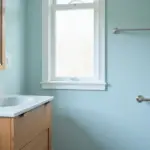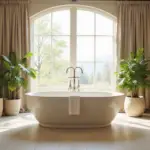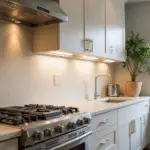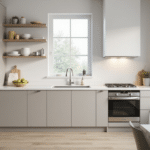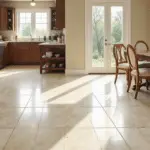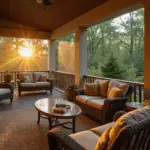The bathroom, often one of the smallest rooms in the house, holds immense potential. More than just a functional space, it can become your private sanctuary—a place to refresh and rejuvenate daily. But creating a bathroom interior design that balances beauty with practicality can feel overwhelming when faced with countless choices and constraints.
Whether you’re planning a complete renovation or simply refreshing your existing space, these 18 essential design strategies will guide you toward creating a bathroom interior that perfectly balances style, comfort, and functionality. From layout optimization to smart technology integration, I’ll share practical insights drawn from my experience in urban design and sustainable spaces. Let’s transform your bathroom from merely functional to genuinely exceptional.
1. Optimize Your Layout for Maximum Space
The foundation of successful bathroom interior design lies in its layout. A thoughtfully planned layout dictates how effectively you can use the available square footage. Even a large bathroom can feel cramped with poor placement, while a well-designed small space can feel surprisingly open and functional. Strategic positioning of fixtures, storage, and walkways creates a comfortable environment that works for your daily needs.

Common layout mistakes include overcrowding fixtures, using oversized vanities in small spaces, neglecting vertical storage opportunities, and failing to consider door swing directions. For best results, measure your bathroom precisely and create a scaled floor plan. Consider existing plumbing locations, window and door placements, and architectural limitations before experimenting with different fixture arrangements.
“The magic of bathroom interior design begins with spatial planning—every inch matters, especially in urban spaces where bathrooms often serve multiple functions.”
The inspiration for this collection struck when I realized that many bathroom designs fail at the planning stage. Consider exploring wet room concepts where the shower isn’t enclosed, streamlining the space by eliminating barriers. Pocket doors that slide into walls can save significant space compared to traditional swinging doors—a game-changer in smaller bathrooms.
2. Choose the Right Vanity: Style Meets Storage
The bathroom vanity serves as both a focal point and a workhorse, providing essential storage while anchoring your bathroom interior design. When selecting a vanity, consider your bathroom’s size, storage needs, overall style, budget, and material durability. Think about countertop materials, sink types (undermount, vessel, integrated), and hardware finishes that complement existing fixtures and color schemes.

Different vanity styles offer varying advantages. Freestanding vanities provide installation flexibility but may not maximize storage. Wall-mounted (floating) vanities create visual spaciousness but require wall reinforcement. Corner vanities maximize space in small bathrooms but offer limited storage. Double vanities work well for couples but need more space. To maximize storage, utilize drawer organizers, dividers, and pull-out shelves to keep items neat and accessible.
The craftsmanship in this collection tells a story of balancing form with function. Before purchasing, measure your plumbing lines to ensure alignment with the vanity’s drain and water supply openings. Consider toe-kick drawers under the vanity for storing extra towels or cleaning supplies—those often-overlooked spaces can significantly increase your storage capacity.
3. Select Durable and Stylish Flooring Options
Bathroom flooring must withstand moisture and heavy traffic while contributing to your overall bathroom interior design aesthetic. The most durable options include porcelain and ceramic tile, luxury vinyl plank (LVP), and natural stone like granite. Porcelain and ceramic resist water damage, scratches, and stains, while LVP offers waterproof properties with comfort underfoot. Granite provides incredible durability but requires periodic sealing.

When choosing flooring, balance aesthetics with practicality. Consider water resistance, slip resistance, and maintenance requirements alongside visual appeal. Textured tiles provide better grip while larger tiles minimize grout lines, reducing cleaning efforts. Beyond traditional options, consider concrete, cork, or epoxy flooring for unique looks with proper sealing and maintenance.
Unlike mass-produced alternatives, this technique allows you to create truly distinctive bathroom interior design. Consider using a herringbone pattern with durable wood-look tile to add visual interest and warmth. Remember that grout is more porous than tile, making it more susceptible to stains and mildew—regular sealing is crucial for maintaining its appearance, especially in high-moisture environments.
4. Illuminate Your Space with Layered Lighting
Lighting profoundly impacts bathroom interior design, affecting both functionality and ambiance. Layered lighting combines multiple light sources to create balanced illumination that addresses different needs. A single overhead light often casts harsh shadows and doesn’t adequately serve activities like applying makeup or creating a relaxing bath atmosphere.

The three main lighting layers serve distinct purposes:
- Ambient Lighting: Provides overall illumination through recessed lighting, ceiling fixtures, or chandeliers
- Task Lighting: Offers focused light for specific activities via vanity lights or sconces flanking mirrors
- Accent Lighting: Highlights architectural details or decorative elements with spotlights or strip lighting
What makes this design special is the way lighting transforms the space throughout the day. Install dimmer switches on all lighting layers to adjust brightness and create different moods. Choose energy-efficient LEDs with a high Color Rendering Index (CRI) to ensure accurate color representation, especially important for tasks like makeup application or shaving.
5. Master the Art of Bathroom Tile Design
Tile remains a cornerstone of bathroom interior design for good reason—it’s durable, water-resistant, and incredibly versatile. When choosing bathroom tiles, consider how size affects spatial perception: larger tiles can make small bathrooms feel more spacious, while smaller tiles add detail and texture. Different patterns dramatically impact visual impression—vertical stacks can elongate walls, while herringbone patterns add sophistication and movement.

Current tile trends include large-format tiles, textured surfaces, geometric patterns, natural stone, penny rounds, creative subway layouts, zellige tiles (handmade Moroccan tiles with slight variations), and porcelain tiles mimicking other materials like wood or concrete. The right grout color choice can either highlight your pattern (contrasting grout) or create a seamless look (matching grout).
The designer’s secret here is to create a feature wall using bold, patterned tile to add visual interest without overwhelming the space. Consider using a tile leveling system during installation to create perfectly flat and even surfaces—those small details make a significant difference in the final appearance of your bathroom interior design.
6. Create a Spa-Like Atmosphere with Showers & Tubs
The shower and tub often serve as the centerpiece of bathroom interior design and are crucial for creating a relaxing, spa-like experience. Key features for a luxurious shower include multiple showerheads (rain shower, body jets, handheld), ample space, frameless glass enclosures, built-in seating, proper ventilation, and high-quality materials like natural stone or porcelain tile.

When selecting a bathtub, consider both bathroom size and personal preferences. Freestanding tubs create an elegant focal point while alcove tubs maximize space efficiency. Soaking tubs offer deeper immersion, while jetted tubs provide massage benefits. Materials matter significantly: acrylic is lightweight and affordable, cast iron retains heat beautifully, and copper offers antimicrobial properties alongside distinctive aesthetics.
The emotional response this evokes begins with sensory engagement. Consider installing a chromatherapy system in your shower or tub to use colored light for influencing mood and relaxation. Elevate your bathing experience with thoughtful accessories like a bath caddy to hold books, candles, and beverages—these small additions significantly enhance the spa-like quality of your bathroom interior design.
7. Play with Color Palettes to Set the Mood
Color profoundly influences bathroom interior design by establishing atmosphere and emotional response. Color psychology suggests that blues and greens evoke tranquility and relaxation, perfect for spa-like bathrooms. Warmer tones like yellows and oranges inject energy and cheerfulness, while neutrals provide a calming backdrop that allows accessories to shine.

For small bathrooms, lighter color palettes generally create a sense of spaciousness by reflecting light. Whites, creams, pastels, and light grays make rooms feel larger, while adding color through accessories prevents sterility. Larger bathrooms support bolder and darker colors like deep blues, greens, or even blacks for luxury and sophistication, though these should be balanced with lighter elements to avoid oppressiveness.
The unexpected color story emerging this year involves earthy tones paired with subtle pastels. Test paint colors under different lighting conditions before committing, as colors appear differently depending on light sources. Remember that blue tones are often associated with cleanliness and hygiene, making them particularly popular choices for bathroom interior design.
8. Implement Smart Storage Solutions to Declutter
A beautiful bathroom interior design quickly loses appeal when countertops overflow with toiletries and essentials. Effective storage creates visual tranquility and functional efficiency. Decluttering is crucial for making spaces feel larger, cleaner, and more spa-like while improving hygiene and simplifying cleaning routines.

Smart storage solutions maximize both space and accessibility:
- Built-in shower niches for toiletries
- Floating shelves above toilets
- Vanity drawer organizers
- Mirrored medicine cabinets with adjustable shelves
- Over-toilet storage units
- Rolling carts for flexible storage
- Tall, narrow cabinets for vertical space utilization
When clients ask us about balancing style with comfort, storage always enters the conversation. Before investing in storage solutions, take inventory of your toiletries, cleaning supplies, and other bathroom essentials to determine exact needs. Studies show that decluttered bathrooms significantly reduce stress levels—making smart storage a worthy investment for both your bathroom interior design and your wellbeing.
9. Pick the Perfect Mirror for Function and Aesthetics
Mirrors significantly impact bathroom interior design by influencing light distribution, spatial perception, and functionality. When selecting mirror size and shape, consider your vanity dimensions—generally, mirrors should be slightly narrower than vanities (24-36 inches wide for single vanities). Rectangular mirrors offer versatility, while round or oval shapes add softness and visual interest.

Mirror frames dramatically affect overall aesthetic: frameless mirrors provide clean, modern looks and easy cleaning; thin metal frames in brushed nickel or matte black suit contemporary designs; ornate wood frames complement traditional styles. Proper lighting integration is crucial—sconces mounted on both sides of mirrors provide even, flattering illumination, while integrated LED lighting offers sleek modernity. Large mirrors, especially when placed opposite windows, reflect light and visually expand rooms.
The interplay between the colors creates fascinating effects when reflected in well-placed mirrors. Consider creating a gallery wall of small, decorative mirrors to add texture and visual interest to your bathroom interior design. Use painter’s tape to outline desired mirror dimensions on the wall before installation to visualize the final result and ensure proper positioning.
10. Accessorize for Polish and Personal Style
Accessories transform functional bathroom interior design into personalized sanctuaries. These finishing touches add character, warmth, and visual interest while reflecting individual taste. They provide opportunities to introduce color, texture, and functionality without major renovations, elevating utilitarian spaces into inviting retreats.

Essential bathroom accessories include:
- Towel bars/rings/ladders in complementary finishes
- Coordinated soap dispensers and dishes
- Decorative trays for organizing countertop items
- Bath mats adding comfort and visual appeal
- Shower curtains introducing pattern and color
- Stylish wastebaskets blending with decor
- Plants bringing freshness and natural elements
- Artwork expressing personality
Beyond the obvious placement, consider using these elements to create a spa-like atmosphere with candles, essential oil diffusers, and plush towels. Start with neutral foundations and gradually introduce accessories, building visual interest layer by layer. This approach allows you to experiment with different bathroom interior design elements before committing to permanent changes.
11. Consider Water-Saving Fixtures for Efficiency
Thoughtful bathroom interior design incorporates environmentally conscious choices benefiting both the planet and utility bills. Water-saving fixtures reduce consumption, lower water bills, and decrease environmental impact. Many local governments offer rebates for installing these fixtures, providing additional cost savings while potentially increasing home value through demonstrated sustainability commitment.

Water-saving options include:
- Low-flow toilets using significantly less water per flush
- WaterSense-labeled showerheads maintaining pressure while limiting flow
- Faucet aerators mixing air with water to reduce usage
- Dual-flush toilets offering options for solid or liquid waste
- Tankless water heaters providing hot water on demand
The sustainable journey of this material involves looking for the WaterSense label from the EPA, indicating products meet specific efficiency and performance criteria. These products use at least 20% less water than standard models without sacrificing performance. Check gallons per flush (GPF) ratings for toilets and gallons per minute (GPM) ratings for showerheads and faucets—lower numbers indicate greater efficiency.
12. Bring Nature In with Bathroom-Friendly Plants
Incorporating greenery into bathroom interior design softens hard surfaces and introduces life and vitality. Plants enhance aesthetic appeal through natural textures, colors, and shapes while improving air quality by absorbing toxins and releasing oxygen. Bathroom humidity creates favorable environments for many plants, making maintenance relatively easy while contributing to relaxation and wellbeing.

Several plant varieties thrive in warm, humid bathroom conditions:
- Snake Plants and ZZ Plants tolerate low light and irregular watering
- Peace Lilies flourish in humidity while filtering air effectively
- Pothos vines cascade beautifully from shelves or hanging planters
- Orchids appreciate bathroom moisture levels
- Ferns love humidity and filtered light
- Air Plants require no soil, just occasional misting
- Spider Plants purify air while producing offspring plants
The environmental story behind this piece began with recognizing how plants can transform sterile bathroom spaces. Create vertical gardens using waterproof shelving or wall-mounted planters to maximize space and create dramatic focal points. Choose pots with drainage holes and well-draining potting mix to prevent root rot in humid bathroom environments—these practical considerations ensure your bathroom interior design remains both beautiful and sustainable.
13. Integrate Smart Technology Features
Technology integration elevates bathroom interior design with convenience and luxury. Popular smart bathroom features include toilets with heated seats and bidet functions, showers with customizable temperature and pressure settings, mirrors with integrated lighting and information displays, touchless faucets, and voice-controlled lighting systems. Leak detection systems prevent water damage, providing peace of mind alongside convenience.

Smart technology enhances bathroom experiences through personalization and efficiency. Imagine stepping into showers pre-set to ideal temperatures, using toilet seats that remain comfortably warm, or checking weather forecasts on smart mirrors while preparing for the day. Voice-controlled lighting and music create customized atmospheres for different moods and times of day, transforming bathrooms into luxurious retreats.
We’ve been working behind the scenes on something special that balances innovation with practicality. Start small by replacing standard light switches with smart dimmers to control ambiance and energy consumption. For more ambitious bathroom interior design projects, consider smart mirrors with built-in speakers and displays for news, weather, or streaming services—technology that genuinely enhances daily routines.
14. Add Depth and Interest with Textures
Texture plays a crucial role in bathroom interior design by counterbalancing the predominance of hard, smooth surfaces. Without intentional texture, bathrooms can feel cold, sterile, and visually flat. Introducing varied textures adds visual and tactile interest, creating inviting, dynamic environments that break monotony and highlight specific features.

Incorporate texture through:
- Natural materials like treated wood, stone, or woven storage baskets
- Varied tile finishes—matte, textured, or patterned
- Soft elements including plush towels, textured rugs, and woven shower curtains
- Hardware with brushed, hammered, or distinctive finishes
- Textured wall treatments resistant to moisture
Running your hand across this material reveals subtle variations that engage the senses. Consider incorporating a shiplap accent wall treated for moisture resistance to add rustic texture. Textured surfaces also help absorb sound, reducing bathroom echo problems common with hard surfaces—an often overlooked benefit in bathroom interior design that significantly improves comfort.
15. Design for Accessibility and Future Needs
Thoughtful bathroom interior design considers accessibility and adaptability, ensuring spaces remain functional as needs change. Accessible design makes bathrooms usable for people of all ages and abilities, addressing mobility limitations and visual impairments. Planning for aging in place prevents costly future renovations while maintaining comfort and independence.

Key accessibility considerations include:
- Ample maneuvering space (minimum 5′ turning radius for wheelchairs)
- Strategically placed grab bars near toilets and showers
- Curbless shower entries or low-threshold pans
- Comfort-height toilets (17-19 inches)
- Lever-handled faucets and door hardware
- Slip-resistant flooring
- Adequate, well-distributed lighting
If you’ve struggled with similar rooms before, you’ll appreciate how accessibility features integrate seamlessly into stylish bathroom interior design. Choose grab bars in decorative finishes that complement overall aesthetics, select sleek lever handles, and install linear drains in curbless showers for minimalist appeal. Floating vanities provide both knee space and contemporary style while enhancing the sense of openness.
16. Ensure Proper Ventilation for Longevity
Proper ventilation forms a critical but often overlooked aspect of bathroom interior design. Without adequate airflow, humidity accumulates, causing mold and mildew growth, peeling paint, warped wood, rusted fixtures, and unpleasant odors. Effective ventilation removes excess moisture, preserving materials and finishes while maintaining a healthy environment.

Bathroom ventilation typically comes from exhaust fans, natural ventilation (windows/doors), or ideally, a combination of both. When selecting exhaust fans, consider appropriate CFM (cubic feet per minute) ratings for your bathroom size, noise levels (measured in sones), energy efficiency, and features like humidity sensors or timers. Run exhaust fans during and for at least 20 minutes after showering to effectively remove moisture.
The challenge of awkward spaces becomes easier when you address fundamental needs like ventilation. Install humidity-sensing exhaust fans for automatic, efficient operation without requiring manual activation. To test your existing fan’s effectiveness, hold toilet paper near it while running—properly functioning fans should hold paper firmly against the grille, indicating sufficient air movement to protect your bathroom interior design investment.
17. Don’t Overlook Hardware and Faucet Details
Hardware and faucets function as bathroom interior design jewelry, significantly impacting both aesthetics and functionality. These touchpoints contribute to perceived quality and overall coherence. Consistent style and finish across all elements create polished, intentional appearances, while neglecting these details can undermine otherwise well-designed spaces.

When selecting hardware and faucets, consider:
- Overall bathroom style (modern, traditional, minimalist)
- Finishes (chrome, brushed nickel, matte black, brass) with consistent application
- Faucet functionality (high-arc for filling containers, low-profile for sleek appearance)
- Material quality and moisture resistance
- Water efficiency ratings
- Ergonomics and ease of use
Look closely and you’ll notice the subtle texture of well-designed hardware makes a significant difference. Consider mixing metals strategically—perhaps brushed brass faucets with chrome cabinet pulls—for unexpected elegance. Before purchasing, order finish samples to compare against existing elements ensuring perfect coordination, and test handle feel and water flow for optimal bathroom interior design that’s beautiful and functional.
18. Set a Realistic Budget and Stick to It
Establishing a clear budget provides essential framework for bathroom interior design decisions, preventing project derailment. Without defined financial parameters, it’s easy to choose high-end finishes or unexpected upgrades that exceed capacity. Well-defined budgets help prioritize essential elements, explore cost-effective alternatives, and maintain control throughout the renovation process.

Many hidden costs can surprise homeowners during bathroom renovations:
- Unexpected plumbing or electrical issues discovered during demolition
- Demolition and debris disposal fees
- Permit and inspection requirements
- Labor cost overruns from complications or delays
- Material price fluctuations
- Accumulating small expenses for tools and supplies
- Necessary contingency funds (typically 10-20% of total budget)
For those worried about maintenance and costs, track spending meticulously using spreadsheets or budgeting apps, maintain records of all receipts and invoices, and communicate clearly with contractors about financial constraints. Consider DIY elements where feasible to reduce labor costs, such as painting or installing accessories. Remember that well-executed bathroom interior design can increase home resale value, but only when completed properly and within reasonable budgets.
Conclusion
Creating stunning bathroom interior design requires thoughtful planning and attention to detail. By optimizing layouts, selecting appropriate materials, and implementing smart storage solutions, you establish a strong foundation. Adding layered lighting, incorporating texture, and selecting the perfect fixtures elevate the space from merely functional to truly exceptional.
Consider both aesthetic appeal and practical concerns like ventilation, water efficiency, and accessibility to ensure your bathroom remains beautiful and functional for years. Bring in natural elements through plants, incorporate technology where it genuinely enhances experience, and don’t overlook the impact of seemingly small details like hardware finishes.
With these 18 essential strategies, you’re well-equipped to transform your bathroom into a sanctuary that balances beauty with practicality—a space that enhances your daily routine while reflecting your personal style. Remember that successful bathroom interior design isn’t about following trends blindly, but rather creating thoughtful spaces that work beautifully for your specific needs and preferences.
\

